
The common footman is a moth of the family Erebidae. The species was first described by Johann Leopold Theodor Friedrich Zincken in 1817. It is distributed throughout Europe and east through the Palearctic to Lake Baikal.

Anestia is a genus of moth in the subfamily Arctiinae.
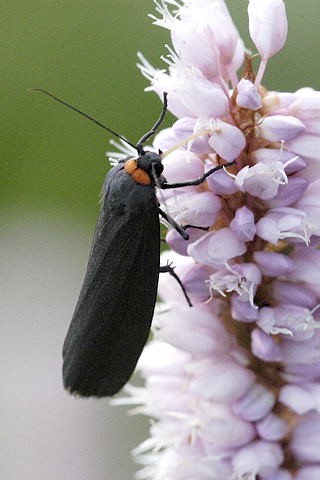
Atolmis rubricollis, the red-necked footman, is a small moth of the family Erebidae. It is found in the summer in forested regions of Europe and Northern Asia. This moth was first described by Carl Linnaeus in his 1758 10th edition of Systema Naturae.

Miltochrista miniata, the rosy footman, is a moth of the family Erebidae. The species was first described by Johann Reinhold Forster in 1771. It is found in the temperate parts of the Palearctic realm – Europe, Asia Minor, Caucasus, northern Kazakhstan, southern Siberia, Amur, Primorye, Sakhalin, southern Kuriles, Heilongjiang, Liaoning, Hebei, Inner Mongolia, Shanxi, Sichuan, Korea and Japan, but may be replaced by Miltochrista rosaria in the eastern Palearctic.

Wittia sororcula, the orange footman, is a moth of the family Erebidae. The species was first described by Johann Siegfried Hufnagel in 1766. It is found in Europe, Anatolia and further east across the Palearctic to southern Siberia and the Amur basin to China.

Eilema caniola, the hoary footman, is a moth of the family Erebidae. The species was first described by Jacob Hübner in 1808.
Parelictis is a monotypic moth genus in the subfamily Arctiinae. Its only species, Parelictis saleuta, the mottled footman, has been recorded from the Australian states of New South Wales and Victoria. Both the genus and species were first described by Edward Meyrick in 1886.
Phaeophlebosia is a monotypic moth genus in the subfamily Arctiinae erected by George Hampson in 1900. Its single species, Phaeophlebosia furcifera, the forked footman, was first described by Francis Walker in 1854. It is found in Australia, where it has been recorded from New South Wales, Victoria, Tasmania and South Australia.
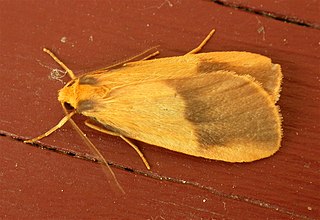
Threnosia heminephes, the halved footman, is a moth of the subfamily Arctiinae first described by Edward Meyrick in 1886. It is found in Australia, where it has been recorded from the Australian Capital Territory, New South Wales and Victoria.
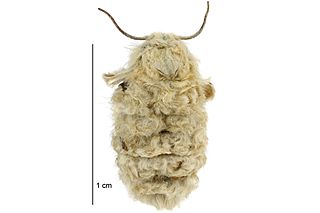
Metacrias erichrysa is a species of moth of the family Erebidae. It is endemic to New Zealand. This species can be found in the lower half of the North Island and western alpine areas of the South Island. The adult female of the species is flightless and buff coloured whereas the male is brightly coloured and a rapid flier during daylight hours. The male of the species is on the wing from mid-November to early January. The species inhabits open herb and tussock fields in mountainous terrain at altitudes of between 900 and 1200 m. Larvae feed on Brachyglottis bellidioides,Festuca novae-zealandiae and indigenous species from the genera Acaena, Muehlenbeckia, Wahlenbergia and Raoulia.
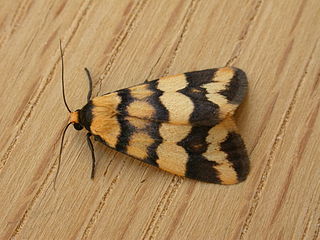
Termessa zonophanes, the double yellow-patched footman, is a moth of the subfamily Arctiinae. The species was first described by Edward Meyrick in 1888. It is known from the Australian Capital Territory, New South Wales, Queensland and Victoria.
Hesychopa chionora, the white footman, is an Australian moth of the subfamily Arctiinae. It was described by Edward Meyrick in 1886. It lives in Victoria, Queensland and New South Wales.
Eressa geographica is a moth of the family Erebidae. It was described by Edward Meyrick in 1886. It is found in Australia.
Hectobrocha pentacyma, the five-banded footman, is a moth of the subfamily Arctiinae. It was described by Edward Meyrick in 1886. It is found in the Australian states of Queensland, New South Wales and Victoria.
Scaptesyle dichotoma, the reticulated footman, is a moth in the subfamily Arctiinae. It was described by Edward Meyrick in 1886. It is found in Australia, where it has been recorded from Queensland, New South Wales, and Victoria.
Thallarcha chrysochoa, the golden footman, is a moth in the subfamily Arctiinae. It was described by Edward Meyrick in 1886. It is found in Australia, where it has been recorded from the Australian Capital Territory, New South Wales and Victoria.
Thallarcha oblita, the hidden footman, is a moth in the subfamily Arctiinae. It was described by Rudolf Felder and Alois Friedrich Rogenhofer in 1875. It is found in Australia, where it has been recorded from the Australian Capital Territory, New South Wales and Victoria.
Thallarcha phalarota, the adorned footman, is a moth in the subfamily Arctiinae. It was described by Edward Meyrick in 1886. It is found in Australia, where it has been recorded from the Australian Capital Territory, New South Wales, Queensland and Victoria.
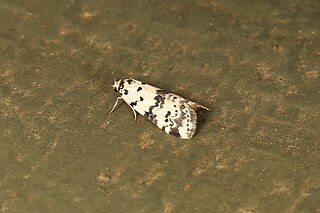
Thallarcha rhaptophora is a moth in the subfamily Arctiinae. It was described by Oswald Bertram Lower in 1915. It is found in Australia, where it has been recorded from New South Wales, Victoria and Western Australia.
Scoliacma pactolias is a moth in the family Erebidae. It was described by Edward Meyrick in 1886. It is found in Australia, where it has been recorded from the Australian Capital Territory, New South Wales, Queensland, South Australia, Tasmania and Victoria.











